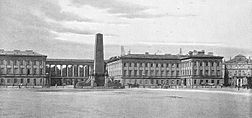|
Saxon Palace
  The Saxon Palace (Polish: pałac Saski w Warszawie) was, before World War II, one of the most distinctive buildings in Warsaw, Poland. After the suppression of the 1944 Warsaw Uprising, the palace was destroyed by German armed forces as part of their deliberate destruction of Warsaw. After the Polish government announced plans to reconstruct the building, ground work commenced in August 2022. Rebuilding is expected to be completed by 2030.[3] HistoryTo World War IThe Saxon Palace had been preceded by a manor houses (dwór) belonging to Tobiasz Morsztyn. After 1661 his brother and heir Jan Andrzej Morsztyn had replaced the manor with a baroque palace with four towers, known as the Morsztyn Palace (Polish: Pałac Morsztynów). In 1713 the Morsztyn Palace was purchased by the first of Poland's two Saxon kings, Augustus II (reigned in Poland 1697–1706 and 1709–33), who had it expanded and remodeled as part of his architectural concept of the Saxon Axis. Work on the palace was completed in 1748 by his son, King Augustus III. In the early 19th century, the Saxon Palace housed the Warsaw Lyceum in which Frédéric Chopin's father Nicolas Chopin taught French, living with his family on the palace grounds. The Palace was remodeled in 1842.[4] InterbellumAfter World War I, the Saxon Palace was the seat of the Polish General Staff. In 1925, the Tomb of the Unknown Soldier was established within the colonnade-topped arcade that joined the Palace's two symmetric wings. The Palace continued to be sandwiched between the Saxon Garden, to its rear, and the Saxon Square in front (which would be renamed Piłsudski Square after the Marshal's death in 1935). In this building, the German Enigma machine cipher was first broken in December 1932 and then read for several years before the General Staff Cipher Bureau German section's 1937 move to new, specially designed quarters near Pyry in the Kabaty Woods south of Warsaw. During World War II, two months after the German suppression of the 1944 Warsaw Uprising, the Saxon Palace was blown up by the Germans as part of their planned destruction of Warsaw.[5][6] Only parts of the central arcade remained, housing the Tomb of the Unknown Soldier, which escaped destruction.[7] Since World War IIThere are plans to reconstruct the Saxon Palace.[8] The palace cellars were excavated in 2006, uncovering some 20,000 objects. The palace's reconstruction was formerly scheduled for completion by 2010.[9] The reconstructed building was planned to house Warsaw's city hall, but due to Warsaw's budget problems caused by the Great Recession (2000s), and subsequent cuts, the reconstruction has been on hold. On 11 November 2018, in celebration of the 100th anniversary of Poland's post-World War I independence, President Andrzej Duda reaffirmed the intent to rebuild the palace.[10] Gallery
See alsoWikimedia Commons has media related to Saxon Palace. References
External links
|
||||||||||||||||||||||||||||
Portal di Ensiklopedia Dunia







